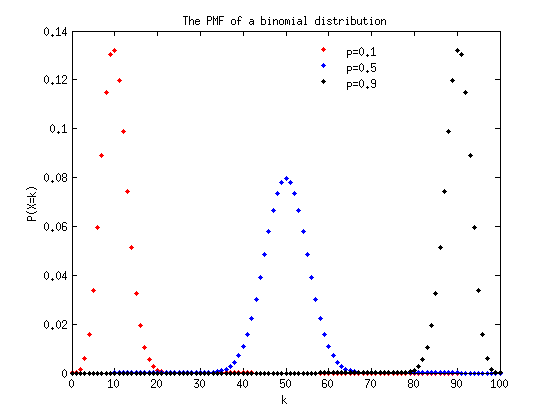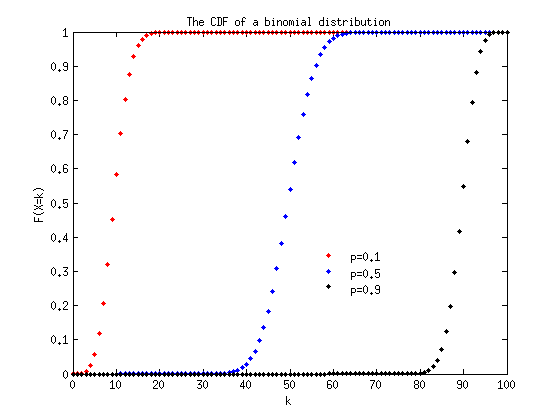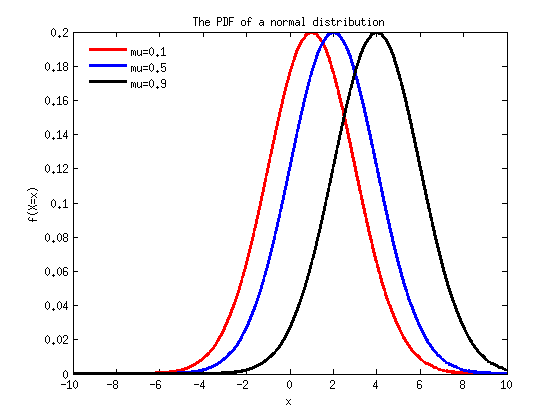Lab 3, Discrete, continouse distribution. (Due on 11:59 PM, Feb 17, 2015)
Any distribution can be plotted with Matlab®. In Lab 3, we will show the impact of different controling parameters on several discrete and continouse distributions we learnt so far. All the distributions that are available in Matlab : http://www.mathworks.com/help/stats/binopdf.html
Contents
Plot the PMF of a binomial distribution by varying p;
Step 1. define neccessary variables(Matlab variables) to code for the binomial PMF formula  .
.
n = 100; % the n parameter in the PMF. p = [0.1, 0.5, 0.9];% the varying p parameter in the PMF. ks = 0:100; % the value X can take.
Step 2. In each iteration of the for loop, calculate the corresponding P according to the binomial PMF formula. Draw a PMF on a figure.
fig1 = figure; % create a figure to draw on. linestyle = {'r.', 'b.','k.'}; for i=1:3 P = binopdf(ks,n,p(i)); % Directly call the binopdf() function to calculate P(X=k) returns a vector of probabilities with the same length as ks plot(ks, P, linestyle{i}, 'linewidth', 3); % .r means red dots. -r means red line. hold on; % hold on for other plotting. end title('The PMF of a binomial distribution'); xlabel('k'); ylabel('P(X=k)'); legend('p=0.1','p=0.5', 'p=0.9','Location','best'); legend('boxoff');

Plot the (Cumulative) Distribution Function of a binomial distribution by varying p;
Step 1. define neccessary variables(Matlab variables) would be used.
n = 100; % the n parameter in the PMF. p = [0.1, 0.5, 0.9];% the varying p parameter in the PMF. ks = 0:100; % the value X can take.
Step 2. In each iteration of the for loop, call the binocdf() function to calculate CDF. Draw a CDF on a figure.
fig1 = figure; % create a figure to draw on. linestyle = {'r.', 'b.','k.'}; for i=1:3 P = binocdf(ks,n,p(i)); plot(ks, P, linestyle{i}, 'linewidth', 3); hold on; % hold on for other plotting. end title('The CDF of a binomial distribution'); xlabel('k'); ylabel('F(X=k)'); legend('p=0.1','p=0.5', 'p=0.9','Location','best'); legend('boxoff');

Plot the PDF of a nomal distribution with varying  and a fixed
and a fixed 
With the similar steps as for the discrete distribution.
sigma = 2; mu = [1, 2, 4]; % the $\mu$ parameter in the PMF. xs = -10:0.0001:10; % the step size is very small now. fig1 = figure; % create a figure to draw on. linestyle = {'r-', 'b-','k-'}; % we use the lines instead of dots now for i=1:3 f = normpdf(xs, mu(i), sigma); plot(xs, f, linestyle{i}, 'linewidth', 3); hold on; % hold on for other plotting. end title('The PDF of a normal distribution'); xlabel('x'); ylabel('f(X=x)'); legend('mu=0.1','mu=0.5', 'mu=0.9','Location','best'); legend('boxoff');

Do you notice that the shape of nomal distribution is bell? Also, the widths of the bells are the same, why? What is the PDF plot with fixed  and varying
and varying  ?
?
Assignments
Here goes the assignments for Lab 3.
Question 1. Plot the PDF and CDF for normal distribution with fixed  and varying
and varying ![$\sigma = [0.5, 1, 2]$](Lab3_eq19836.png) . Draw your observations with two to three sentences.
. Draw your observations with two to three sentences.
Question 2. Plot the PMF and CDF for geometric distribution with varying ![$p=[0.1, 0.5, 0.9]$](Lab3_eq22937.png) .
.
Submission. Put all of your code, figures, writeups in a single document with .doc or .docx or .pdf format. Submit the document through blackboard. Attention, .txt format is not acceptable.